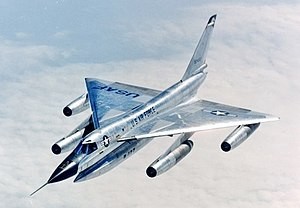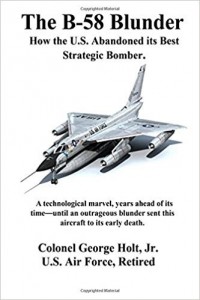I first saw a picture of the Convair B-58 Hustler in C.B. Colby’s 1966 book Jets of the World: New Fighters, Bombers and Transports. I discovered the book in the library of Buena Vista Elementary school. The year was 1972 and I was in the second grade. As best as I recall, the library had several books on aviation – it was not long before I checked them all out.
The B-58 is truly a thing of beauty. The airplane exudes jet-age symmetry. With its sleek, graceful design and proportions that made its radar cross section smaller than other bombers, the B-58 was the marriage of technology and an artisan’s thoughtful crafting. Its delta wing design conveyed power and agility. It was also the first American bomber capable of reaching Mach 2+ speed.
Today the B-58 Hustler is a forgotten airplane, even though it has a strong following of aviation enthusiasts, most who have only seen that aircraft in books or aviation museums. 118 B-58s were built. They served in the U.S. Air Force from 1960 to 1970. Today, only eight of these innovative bombers survive in museums throughout the United States.
Colonel George Holt’s The B-58 Blunder: How the U.S. Abandoned its Best Strategic Bomber puts on display the reasons why the Strategic Air  Command (SAC) chose the development of the B-58 as a suitable candidate to deliver nuclear weapons inside the Soviet Union. The story of the B-58 Hustler, as is often the case with other airplanes, is complex. What makes The B-58 Blunder an informative book has to do with the writer having spent thirty-one years in the U.S. Air Force, including three years as navigator on the B-58.
Command (SAC) chose the development of the B-58 as a suitable candidate to deliver nuclear weapons inside the Soviet Union. The story of the B-58 Hustler, as is often the case with other airplanes, is complex. What makes The B-58 Blunder an informative book has to do with the writer having spent thirty-one years in the U.S. Air Force, including three years as navigator on the B-58.
After World War II, the U.S. Strategic Air Command began taking serious the Soviet Union’s plan for communist world domination. It became apparent to some U.S. leaders that if communism modeled itself by the dictum that “the ends justify the means,” then the Soviet Union’s military expansionism and intent to use nuclear weapons was consistent with its totalitarian modus operandi. This is the reason that U.S. long-range strategic bombers came into existence in the first place.
The B-58 had a maximum altitude of over 63,000 feet. “The B-58 had a superior radar bombing system,” Colonel George Holt informs us. In addition, it was a good aircraft for low level missions. Colonel Holt is adamant that the B-58 was an airplane that was loved by the pilots who flew it. The bomber had a crew of three: pilot, navigator/bombardier, and a defensive systems operator. In place of ejection seats, the airplane had ejection pods.
Colonel Holt’s book compares the B-58 to the B-52, and also to the B-47. For a while, the three strategic bombers saw service with the United States Air Force during the same time. The author offers compelling arguments why it was a mistake to discontinue the B-58 in 1970. While there are many reasons why the B-58 was discontinued, Colonel Holt energetically offers a list of myths and facts about the bomber.
Books on aviation history always tell the story of the people who know an airplane best – the flyers. The B-58 Blunder contains personal anecdotes worth passing along to future generations about a time when Western democracies commandeered steady-hand convictions and courage to defend their populace.












Geef een antwoord